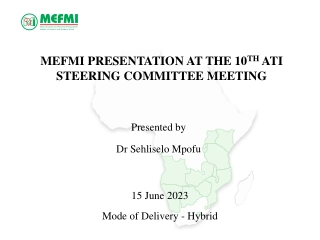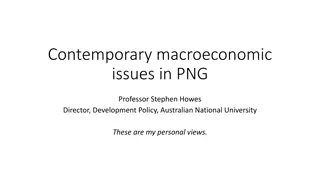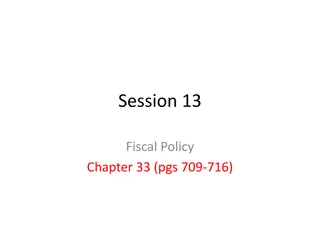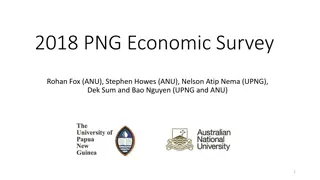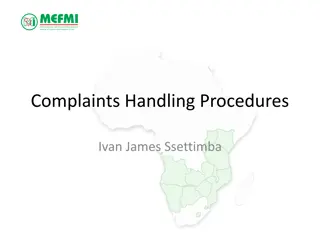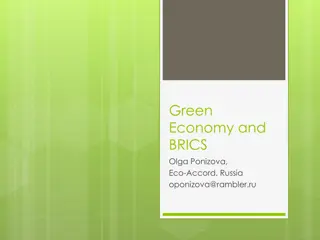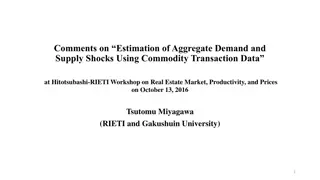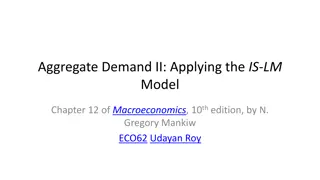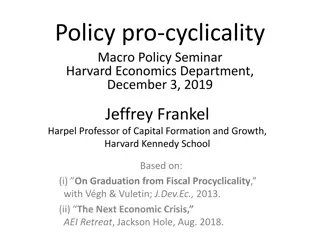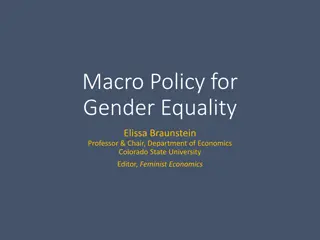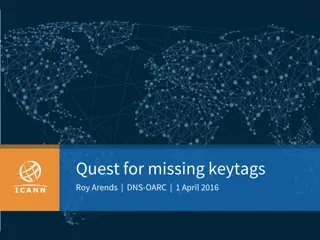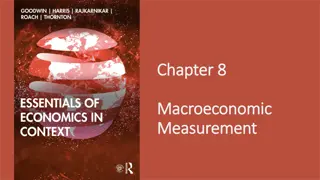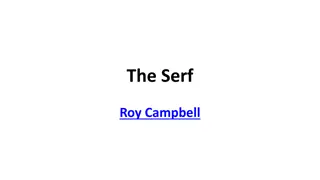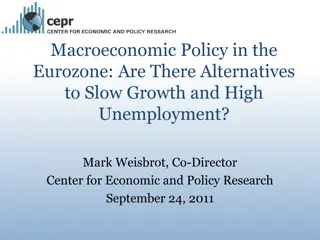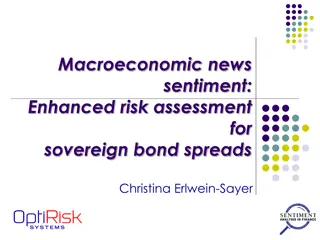Macroeconomic Theory of the Open Economy by Udayan Roy
This presentation discusses key concepts related to the open economy, such as net exports equaling net capital outflow, national saving equaling domestic investment plus net capital outflow, the loanable funds theory of the real interest rate, and the relationship between saving, investment, and net capital outflow. It explores the real exchange rate, purchasing-power parity theory, and the accounting identity of savings, investment, and net capital outflow. The loanable funds theory is explained in detail, highlighting the equilibrium between the supply and demand for loanable funds.
Download Presentation

Please find below an Image/Link to download the presentation.
The content on the website is provided AS IS for your information and personal use only. It may not be sold, licensed, or shared on other websites without obtaining consent from the author. Download presentation by click this link. If you encounter any issues during the download, it is possible that the publisher has removed the file from their server.
E N D
Presentation Transcript
A Macroeconomic Theory of the Open Economy Udayan Roy: http://myweb.liu.edu/~uroy/index.html
Prerequisites Things you need to know before you see the rest of this presentation: Net exports are always equal to net capital outflow: ?? = ??? National saving is always equal to domestic investment plus net capital outflow: ? = ? + ??? The loanable funds theory of the real interest rate, for closed economies National saving = private-sector saving + government saving Private-sector saving = ? ? ? Government saving = ? ?
Prerequisites Things you need to know before you see the rest of this presentation: The real exchange rate is the price of domestic products relative to similar foreign products Calculated as ? ?/? Purchasing-power parity theory of the real exchange rate ? = 1 ? ?
An Accounting Identity: S = I + NCO We have seen before that ? = ? + ???. And we have seen before that it makes sense: A nation s saving must end up being loaned to domestic borrowers or foreign borrowers. The loans made to domestic borrowers will end up as investment spending mainly by domestic firms (I). And the loans made to foreigners will be net capital outflow (NCO). Therefore, ? = ? + ???.
Loanable Funds Theory of the Real Interest Rate Now, in a free-market economy, people and/or firms cannot be forced to do this or that. Therefore, desired saving by households must be equal to desired investment spending by firms and households plus desired net capital outflow. How is this accomplished? How are these desired amounts brought into line?
Loanable Funds Theory of the Real Interest Rate The theory of loanable funds says that: There s a market for loanable funds The supply of loanable funds = desired national saving (S). This supply depends on many factors, including the real interest rate. The supply of loanable funds increases when the real interest rate increases. The demand for loanable funds = desired domestic investment spending (I) + desired net capital outflow (NCO). This demand depends on many factors, including the real interest rate. The demand for loanable funds decreases when the real interest rate increases. The real interest rate reaches an equilibrium level at which supply is equal to demand In this way, we get ? = ? + ??? even when the variables are interpreted as the desired amounts.
The Market for Loanable Funds: Supply Real Interest Rate Supply of loanable funds (National saving, S) Quantity of Loanable Funds Supplied
The Market for Loanable Funds: Demand Real Real Interest Rate Interest Rate + Demand for loanable funds for domestic investment (I) Demand for loanable funds for net capital outflow (NCO) Quantity of loanable funds demanded for domestic investment Quantity of loanable funds demanded for net capital outflow
The Market for Loanable Funds: Demand Real Interest Rate Demand for loanable funds (domestic investment plus net capital outflow, I + NCO) Quantity of Loanable Funds Demanded
The Market for Loanable Funds: Equilibrium Real Interest Rate Supply of loanable funds (National saving, S) Equilibrium Real Interest Rate Demand for loanable funds (domestic investment plus net capital outflow, I + NCO) Quantity of Loanable Funds Equilibrium Quantity
The Market for Loanable Funds: Equilibrium Real Real Real Interest Rate Interest Rate Interest Rate Supply (S) Equilibrium real interest Equilibrium rate Net Capital Outflow (NCO) Investment (I) Demand (I + NCO) Investment (I) Net Capital Outflow (NCO) Quantity of Loanable Funds Equilibrium net capital outflow Equilibrium saving Equilibrium investment
The Market for Loanable Funds: Equilibrium Note that the loanable funds theory predicts that an increase (meaning a shift to the right) in the national saving curve will reduce the real interest rate, and increase the equilibrium amounts of S, I, and NCO. As an exercise, use the loanable funds theory to predict the effects of (i) a shift to the right of the investment curve, and (ii) a shift to the right of the net capital outflow curve. Real Real Real Interest Rate Interest Rate Interest Rate Supply (S) Equilibrium real interest Equilibrium rate Net Capital Outflow (NCO) Investment (I) Demand (I + NCO) Investment (I) Net Capital Outflow (NCO) Quantity of Loanable Funds Equilibrium net capital outflow Equilibrium saving Equilibrium investment
An Accounting Identity: ?? = ??? We have seen before that the actual levels of net exports and net capital outflow must be equal: NX = NCO. But, in a free-market economy, people and/or firms cannot be forced to do this or that. Therefore, desired net exports must be equal to desired net capital outflow. How is this accomplished? How are these desired amounts brought into line?
The Market for Foreign-Currency Exchange Just as we may imagine a market in which ice cream is exchanged for currency, or a market in which Amazon shares are exchanged for currency, we may imagine a market in which different currencies are exchanged for each other. That s the market for foreign-currency exchange. We assume that in this market there is a supply and a demand for every currency. We assume that this market s price reaches the equilibrium level at which supply and demand are equal.
The Market for Foreign-Currency Exchange The supply of the domestic currency = desired net capital outflow (NCO). This supply depends on many factors, but not on the real exchange rate. Recall that the determination of desired net capital outflow was determined in the market for loanable funds before I even mentioned the real exchange rate. The demand for the domestic currency = desired net exports (NX). This demand depends on many factors, including the real exchange rate. The demand for the domestic currency decreases when the real exchange rate increases.
The Market for Foreign-Currency Exchange The real exchange rate reaches an equilibrium level at which supply is equal to demand In this way, we get ?? = ??? even when the variables are interpreted as the desired amounts.
Net Exports and the Real Exchange Rate Real Exchange Rate Demand for domestic currency (net exports) Quantity of domestic currency exchanged for foreign currency
Net Capital Outflow and the Real Exchange Rate Real Exchange Rate Supply of domestic currency (net capital outflow, determined in the market for loanable funds) Quantity of domestic currency exchanged for foreign currency Equilibrium NCO and equilibrium NX
The Market for Foreign-Currency Exchange Real Exchange Rate Supply of domestic currency (net capital outflow, determined in the market for loanable funds) Equilibrium real exchange rate Demand for domestic currency (net exports) Quantity of domestic currency exchanged for foreign currency Equilibrium NCO and equilibrium NX
The Unusual Case of Purchasing-Power Parity Real Exchange Rate Supply of domestic currency (net capital outflow, determined in the market for loanable funds) Equilibrium real exchange = 1 rate Demand for domestic currency (net exports, PPP) Quantity of domestic currency exchanged for foreign currency Equilibrium NCO and equilibrium NX
Simultaneous Equilibrium in Two Markets We need to join together the two markets that we ve been discussing the loanable-funds market and the foreign-currency exchange market to get to a coherent understanding of long-run open-economy macroeconomics
Simultaneous Equilibrium in Two Markets (a) The Market for Loanable Funds (b) Net Capital Outflow Real Real Interest Rate Interest Rate Supply r r Demand Net capital outflow, NCO Quantity of Loanable Funds Net Capital Outflow Real Supply Exchange Rate E Demand Quantity of Domestic Currency (c) The Market for Foreign-Currency Exchange
Effects of Policy Changes and Unforeseen Events The point of building a macroeconomic theory of an open economy is to be able to say something that is not totally idiotic about the likely consequences of some policy change or unforeseen event We will now see what our theory says about the effects of: A tax cut and/or an increase in government spending An import tariff or an import quota Political instability and capital flight
A Tax Cut and/or an Increase in Government Spending Recall that: The supply of loanable funds = national saving (S) National saving = private-sector saving + government saving Private-sector saving = ? ? ? Government saving = ? ? Therefore, a tax cut and/or an increase in government spending implies that T G decreases (that is, government saving decreases) Therefore, national saving (S) decreases This shifts the supply of loanable funds to the left
A Tax Cut and/or an Increase in Government Spending 1. A tax cut or spending hike reduces the supply of loanable funds . . . (a) The Market for Loanable Funds (b) Net Capital Outflow Real Real S Interest Rate Interest Rate S B r2 r2 A r r 3. . . . which in turn reduces net capital outflow. 2. . . . which increases the real interest rate . . . Demand NCO Quantity of Loanable Funds Net Capital Outflow Real S S Exchange 4. The decrease in net capital outflow reduces the supply of domestic currency to be exchanged into foreign currency . . . Rate E2 E1 5. . . . which causes the real exchange rate to appreciate. Demand Quantity of Domestic Currency (c) The Market for Foreign-Currency Exchange
An Import Tariff or an Import Quota An import tariff is a tax on imported goods An import quota puts a limit on the quantity of imports Either way, imports will decrease, assuming all other factors that affect imports (such as the real exchange rate) are unchanged Therefore, net exports (NX = exports imports) will increase. As a result, the demand for the domestic currency in the market for foreign-currency exchange will shift to the right. As the curves for S, I, and NCO are unaffected, the market for loanable funds will be unaffected.
An Import Tariff or an Import Quota (a) The Market for Loanable Funds (b) Net Capital Outflow Real Real Interest Rate Interest Rate Supply r r 3. Net exports, however, remain the same. Demand NCO Quantity of Loanable Funds Net Capital Outflow Real Supply Exchange Rate 1. An import quota increases the demand for domestic currency . . . E2 2. . . . and causes the real exchange rate to appreciate. E D D Quantity of Domestic Currency (c) The Market for Foreign-Currency Exchange
Political Instability and Capital Flight An increase in political instability is likely to cause an increase in net capital outflow (also called capital flight, when the outflow is large), assuming all the other factors that affect NCO are unchanged. This will shift the NCO curve to the right. As the two main sources of the demand for loanable funds are investment (I) and net capital outflow (NCO), the demand for loanable funds will shift right.
Political Instability and Capital Flight (a) The Market for Loanable Funds (b) Net Capital Outflow Real Real 1. An increase in net capital outflow. . . Supply Interest Rate Interest Rate r2 r2 r1 r1 D2 3. . . . which increases the interest rate. D1 NCO2 NCO1 Quantity of Loanable Funds Net Capital Outflow 2. . . . increases the demand for loanable funds . . . Real S S2 Exchange Rate 4. At the same time, the increase in net capital outflow increases the supply of pesos . . . E 5. . . . which causes the peso to depreciate. E Demand Quantity of Domestic currency (c) The Market for Foreign-Currency Exchange
Summary of Predictions National Saving (S) Domestic investment (I) Net capital outflow (NCO) = Net exports (NX) Real interest rate Real exchange rate Tax cut and/or increase in government spending Import tariff and/or import quota No change No change No change No change Increase in political instability
The Unusual Case of Purchasing-Power Parity Real Exchange Rate Recall that under the unusual case of purchasing-power parity, the net exports (NX) curve is horizontal at the real exchange rate of 1. Supply of domestic currency (net capital outflow, determined in the market for loanable funds) Equilibrium real exchange = 1 We could repeat the three prediction exercises we just did with this horizontal NX curve instead of the more common negatively-sloped NX curve. rate Demand for domestic currency (net exports, PPP) The predictions would be the same as before, except that the real exchange rate would remain unchanged (at 1) in all cases. Quantity of domestic currency exchanged for foreign currency Equilibrium NCO and equilibrium NX


